ABS Powder 15 Airbag Review
The ABS Avalanche Airbag System company has been around the longest of the airbag manufacturers and it shows in the construction and details of their ABS Powder 15. While the basic concept is the same as other airbags, the Powder 15 has quite a few unique features that make it ideal for a small airbag touring pack. For a real-life video of an ABS Dual System bag being deployed in the French backcountry, click here.
Overview
A very well made and designed pack that features excellent detailing without going over-board on marketing features. It is comfortable, carries well and has enough capacity to use as a day touring pack or for mechanized skiing. The ability to swap out different “packs” onto a single base unit is nice. The Powder 15 is lightest of the three packs I tested and its trim size makes you forget you are even carrying an airbag pack. On the downside, it is the most expensive of the three packs I tested.
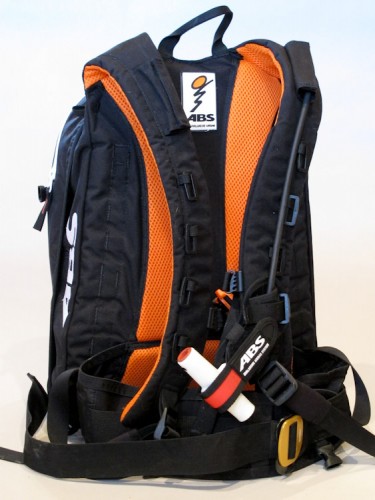
The ABS Powder 15. The eight plastic loops on the shoulder straps (four on each side) allow the trigger system to be moved to either side for left or right hand pulling, or up/down on the shoulder strap so you can have the trigger exactly where you want it.
Nitrogen Gas
ABS uses nitrogen gas instead of compressed air as the nitrogen is not affected by temperature or elevation. “So what?” you say, or at least I did when I first heard this, but it makes sense, especially for skiing. Deploying an airbag on Thompson Pass (2,800′) versus a Colorado 14,000′ peak, or in minus 20 degree Montana weather versus a baking hot day in the Sierra’s will result in radically different amounts of bag pressure. Nitrogen helps even this out, which is why it is also used for inflating race car tires. For refills, you need to find an ABS dealer and then exchange the used cylinder/trigger kit for a fully activated one for a fee.
Explosive charge for trigger
Instead of using a wire cable to trigger the airbags, the ABS system has a small explosive charge in the handle that when detonated sends pressure through a tube running over your shoulder and ruptures a disk which allows the bags to inflate. This has the advantage of fewer moving parts to break or freeze and also allows the handle to be completely removed for travel or loading in/out of cars, helis or trams. It raises a big question-mark about air travel, but then again airlines allow hunters to travel with ammunition, so perhaps this is the same.
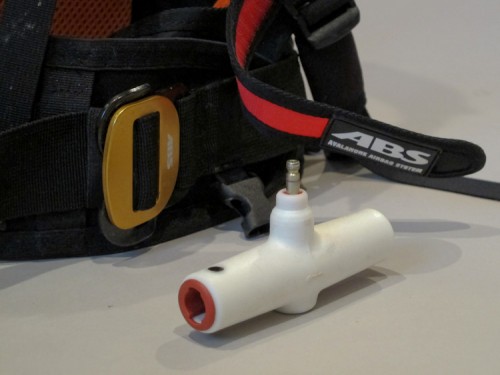
On the Powder 15, the handle contains an explosive charge which in turn ruptures a copper disk on the nitrogen cylinder and then fills the airbags. The handle can be completely removed for safe travel in a heli, car, snowcat, tram, etc..
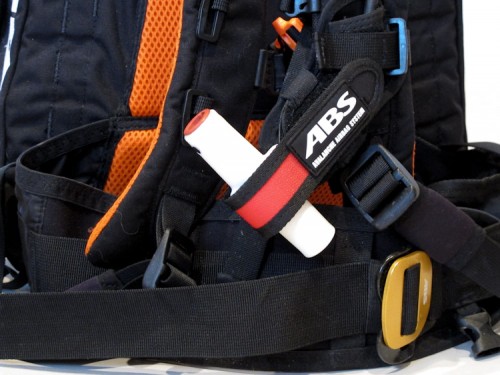
The trigger has a velcro guard over it for times when you want the system activated in the "stand by" mode, like for skiing through trees or hiking up. The strap can be pulled off to the side to place the trigger in "full alert" mode, like when you are skiing a suspect slope. The "T" shape of the handle isn't ideal for use with mittens, but isn't too bad either.
Dual System
The Powder 15 uses the ABS Dual System, which entails two separate venturi valves and two separate 85 liter airbags. The two systems work unison, but if one fails (say the bag pops on a rock), it doesn’t affect the other.
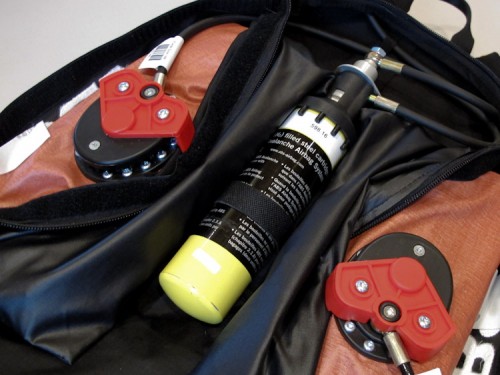
A photo of the ABS "Dual System" showing the two red venturi valves (most airbags just have one). When inflating, 70% of the volume comes from air being sucked into the venturis from the outside, not from the cylinder itself, so the Dual System is like having two lungs instead of one and you get a faster fill.
Pack & Carrying Capacity
For a $1,152 pack, ABS has shown commendable restraint from adding tons of extra junky features to the Powder 15 pack itself. There is a small top key/wallet pocket and then a main pocket with internal sleeves for shovel handles/blades and probes, as well as enough room to carry the basics (jacket, food, water). It is an easy pack to use and carries well. On the to-be-desired side, I wish it had more options for strapping gear to the outside and I prefer lighter fabric colors for packs as black seems to swallow all available light and make it hard to find things inside the pack.
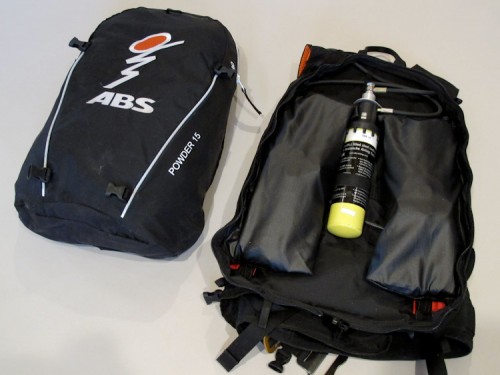
The Powder 15 with its "bag" removed. The part on the right is all of the airbag mechanism and harness. Different size and purpose bags can be zipped onto the ABS frame.
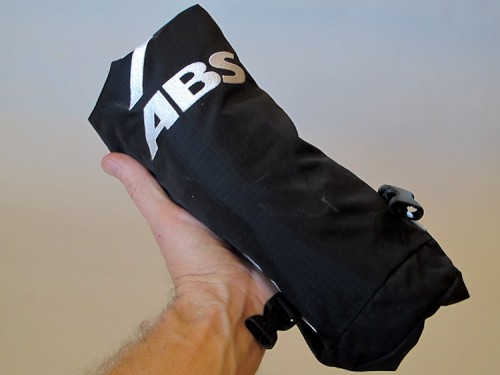
The ABS Powder 15 "bag" taken off the frame and rolled up. It is very light, simple and basic, which I think is a big plus.
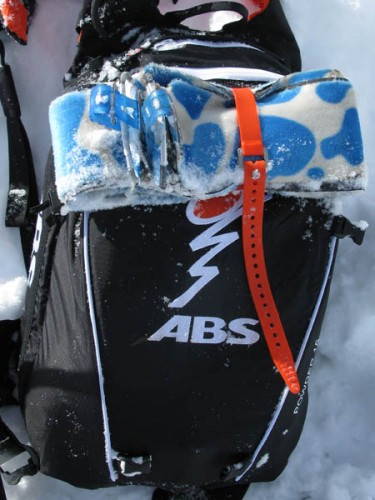
By nature, there's not much room in a 15-18 liter pack, so you often have to strap jackets or skins to the outside. The ABS Powder 15 could use a few more attachment points, but you can also make due in a pinch.
Details:
Velcro waist belt – This is a small, but nice detail. Airbag packs forgo dainty Fastex buckles and use a beefier two-part metal buckle for the waist belt which becomes a pain to get into and out of over the course of doing it ten times a day. The ABS packs allow you to Velcro the waist belt together, which not only makes it easier to eventually buckle the harness, but also works well for ascending safe lines when you want to just have the waist belt on loosely. The steel buckle on the ABS pack is a nice trim little unit that stays out of the way.
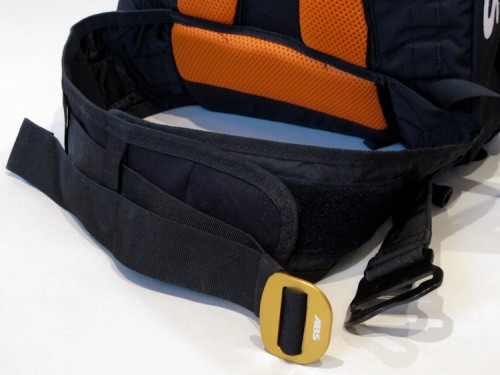
A close-up of the Velcro waistbelt and steel buckles. The Velcro is great for skinning up as it holds the pack comfortably in place and keeps the buckles from dangling around like wind chimes.
Helmet Hammock – The Powder 15 comes with a detachable 4-point exterior helmet hammock on the back.
Ski Carrying Method – None, although it is easy to rig a diagonal/vertical strap system to the helmet hammock buckles with some foresight.
No Gauge on the Nitrogen Cylinder – Unlike the compressed air cylinders on other airbags, the nitrogen cylinders on ABS packs do not have a dial gauge telling you what the tank pressure is. As a life-saving device this is a bit disconcerting as there is no visual way to ensure the cylinder is full, aside from taking it out and weighing it, which is what ABS recommends. The plus side of this is that it weighs less and is smaller.
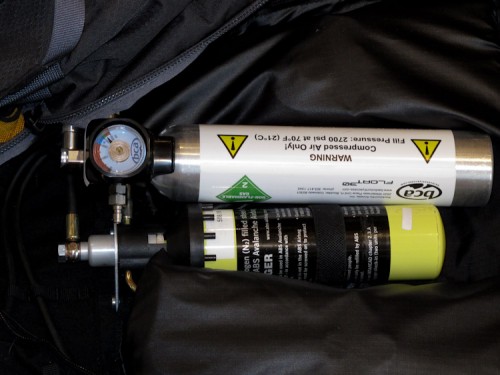
The ABS nitrogen cylinder on the bottom and a BCA air cylinder with dial gauge on the top for size comparison.
Flying with Nitrogen & Explosives – This could potentially be a concern if you were flying commercial airlines to go on a heli-skiing trip. Personally, I wouldn’t take an airbag pack on an expedition (too heavy), so this isn’t a big deal for me.
These small airbag packs are mainly intended for mechanized skiing, but if you can live with minimal carrying capacity, the Powder 15 works great for touring as well. The Powder 15 is lightweight and trim enough that I would carry it for the majority of my Wasatch skiing, which is a key issue for me. If a pack is too heavy or uncomfortable, I won’t use it all the time, which you need to do in avalanche terrain.
________________________________
Help support StraightChuter.com and get some harness buckle practice with a Black Diamond Alpine Bod Harness from Backcountry.com. Click on the photo below…
Category: Gear Reviews

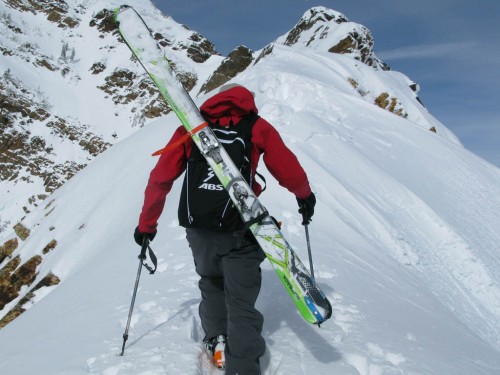
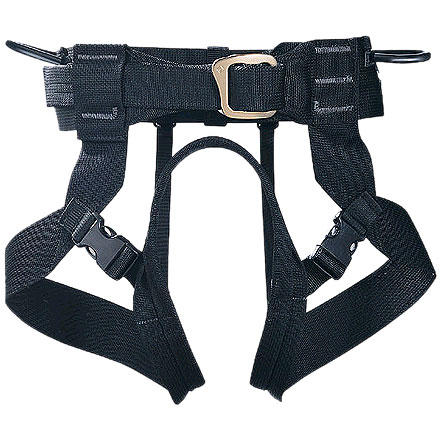








I know it’s heresy to say but I think that given the survival statistics I’d rather carry the weight of an airbag than the typical beacon, shovel, probe combo that weighs nearly 3 pounds. Stay on top and stay alive.
The idea that Nitrogen is better at low temperatures is big myth. See here for test: http://powertank.com/truth.or.hype/
Nitrogen however is non-flammable and non-corrosive, both providing benefits over compressed air.
How is nitrogen different from atmosphere ( [78% N_2, 21% O_2 (dry air)] + 1-4% water) in this context? The ideal gas law (and more accurate approximations) applies essentially equally to both.
Googling about suggests that the primary advantage of nitrogen is related to gas leakage through rubber, especially at higher temperatures. So long as the water is removed from compressed air, I’d expect avalanche airbag performance to be indistinguishable between nitrogen and compressed air in any conditions.
If the oxygen were to leak out of a high pressure cylinder charged with atmosphere, the cylinder would retain 80% of its original charge (and be ~98% charged with nitrogen).
I vote for nitrous oxide hooked to both airbag and hydration tube…good for both high risk skiing and apres partying.
Gonna have to agree with Charlie on this one.
Marketing hype over physics.
Hi Charlie – When it comes to The Ideal Gas Law, I’m way out of my league. I was curious as to why ABS used nitrogen instead of compressed air and that was the official answer from the company.
Nitrogen is used for some things because it is dry (no water vapor) and that decreases variations with temperature and pressure. This could be important for race tires but unlikely important for any passenger car. Compressed air can be dried and 100% dried compressed air would behave similarly to dry nitrogen. I don’t know how dry the compressed air refill you’d get from a place like a dive shop is. Maybe they are using nitrogen just to require that the refill is dry (plus marketing advantage of course).
I’ve been using an ABS Vario 18 Ultralight all season in the Wasatch and feel like it’s the perfect size for our style day tours, with the option to go 30 or 50 liters for a little extra $. I like how it carries it’s weight really close in to your body. I honestly don’t notice a difference between it and my old avalung pack (though the gain was something like 2 lbs). I was able to get a German shop to send the carbon canister to me, even though they’re supposedly not legal in the US yet. It weighs half of what the steel one does. It also carries my split board nicely, in solid or ski mode. I’m psyched I got the ABS, it really makes the BCA pack look like junk in a side by side comparison.
For what it’s worth, a pro ski-guide up here in AK got slid on just a few days ago while doing snow stability work and was buried a few feet deep despite deploying his airbag. Very fast companion rescue saved the day. Don’t get me wrong; all the data on these types of packs seem to point toward giving you the best chance of surviving a big slide, but burial is still possible.
In aerospace “dry” nitrogen is used because it’s inert and doesn’t support corrosion. Furthermore, in a aircraft tire application, when the wheel fuse plug releases due to an over temperature event, the last thing you want is adding more oxygen to a hot brake, thus making a bad situation worse. Also as mentioned previously, Nitrogen particles are larger and less apt to permeate through a nitrile rubber seal.
How might this relate to this application. When air is compressed the water contained condenses, this water would support corrosion of the canister and/or could freeze-up or prevent full opening of the air valve. Since this is a safety device, you want it to have a very high probability of working.
My two cents.
have you seen Mystery Ranch airbag pack? looks sweet.
airbags one of the greatest innovations ever saves lives everyday.